2015-06-26
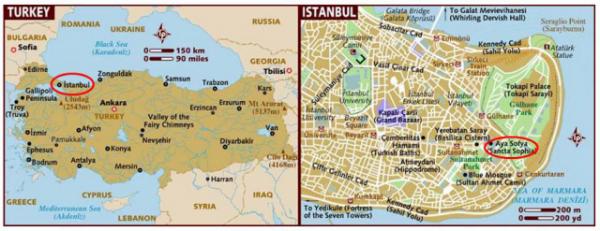
【Aiden in English】 Churches are a legitimate way to showcase art. Some architectures are matched by those of the Roman, Byzantine, and Ottoman Empires. Arriving in Europe, we could not escape the lush history of religion. Religion, to some extent, is the history of an exotic area. Among all the religions in the world, one emerges from the rest, and this one is Islam. With them came a type of church that defined every Christian, Catholic, or Orthodox architectural law. It became a mosque. We have arrived in Istanbul, the largest city in Turkey and the only city in the world on two continents. Here, each civilization from all three significant empires has left behind fascinating aspects of its diverse cultures and traditions. And well, let's say Istanbul incarnates highly religious beliefs. When I mention it, I mean going to extremes. Today's highlight was the famous Hagia Sophia, also known as the Church of Holy Wisdom. This wondrous model of Byzantine architecture was built by Constantine the Great in 325 and converted into a mosque by Sultan Mehmet in 1453. The Islamic faith doesn't permit religious iconic imagery in a place of worship. Still, the Byzantine mosaics were so exceptional that they weren't destroyed; instead, they were plastered over and incorporated additional Muslim elements. They were only dramatically revealed in 1936 when the building became a museum. The minarets rose high up into the sky, spiraling up and up as if they were reaching for the clouds. The shining gold dome, sparkling with reflected lights, made the air around it seem to shimmer. Unlike in Europe, the unique mosaic marble and pillars held up a massive dome decorated with mosaics. However, a few changes have been made to the building over the years. It had collapsed twice previously due to the miscalculations of the dome's weight and pressure. The knowledge of that piece of information didn't exactly calm my nerves. So, throughout the tour, instead of saying and repeating, "Don't look down," I whispered: "Don't look up!" I took special notice of the floor and the lower walls. The color varied, but as far as I could tell, the material appeared to be the same as that of all the Greek churches I visited. You guessed it (hopefully)! It was marble! Yet, why were there green and red variations of colors? The answer was that the white marble on the floor was local from Ephesus, while the ones in different colors were imported from Egypt and other Mediterranean countries. That led to the question of why the mosque absolutely had no paintings. Every picture, pattern, or decoration was a mosaic of elements. The work was nice, but not outstanding. What astonished me was how they placed the piece of art on the dome roof. They had to work with the dome on the ground and then carefully lift it onto the walls. Or people had to get a considerable boost from a platform to reach the roof, not to mention putting tiny pebbles into place. The building mainly resembled the Byzantine style. The mosques also developed various styles. They had the other styles of the world as ingredients, and the architect of Hagia Sophia tossed them in the oven, and out came … whatever masterpiece you call this. The Islamic culture gained much fame through mosques because nothing resembles these structures of glory. The Christian churches are significant, but sometimes, something different turns into what we need for a masterpiece. 【红霞译】
教堂可谓艺术再现形式,某些出自古罗马“力量”、拜占庭“东罗马”及奥斯曼“强大”帝国的宗教建筑风格迥异,彼此之间形成了鲜明对比。一旦走进欧洲,我们根本无法回避早已根深蒂固的宗教历史,宗教俨然与异国风情密不可分。
纵观天下所有宗教,伊斯兰教彻底打破基督教、天主教、东正教的清规戒律,全新创出与众不同的清真寺。眼下我们置身土耳其规模最大、世界上唯一地跨欧亚两大陆的城市,这个曾为三大帝国首都的君士坦丁堡(现为伊斯坦布尔“进城”)承袭了多元性文化以及本民族传统之精髓,将神圣的宗教信仰推向极致,甚至可以说达到了非常极端的境地。
今天我们出游焦点集中在著名的清真寺——圣索非亚大教堂,也叫上帝圣智教堂。公元325年间,由君士坦丁大帝始建这座美轮美奂的拜占庭式建筑;1453年,苏丹王穆罕默德“先知”着手改造成清真寺。伊斯兰教规通常不允许在敬拜真主的地方出现圣像,但因欣赏拜占庭马赛克“镶嵌工艺”才没有完全销毁基督殿堂,只不过涂上石灰将原有象征基督教的部分掩盖起来,重新加固装修并增设了具有穆斯林特色的建筑结构,直到1936年圣索非亚大教堂作为博物馆进入公众视线,历史真相才昭然若揭。
圣索非亚大教堂的尖塔直冲云霄,而且一个赛过一个,大有欲与天公试比高之势;穹窿顶尖金光闪耀,反射的余辉令周围一切黯然失色。与欧洲其它教堂不同,独树一帜的马赛克大理石柱支撑对角线为直径的圆顶,上面全部装饰着镶嵌图案,多年来该清真寺不断维修加建,之前曾因穹顶重量和压力计算失误而出现过两次倒塌事故,听来不免令人心惊肉跳,所以在参观期间,我不是反复告诫自己莫往下看,而是喃喃地提醒自己:“千万别抬头朝上张望!”我有意盯着地面几乎接近墙角,眼前五颜六色,所用材料倒与我去过的希腊所有东正教堂没啥两样,你猜得出(希望如此)!没错,正是大理石!但为什么有绿色和红色不同颜色变化呢?原来白色大理石来自本国以弗所“理想城”,而其它带色的则全部从埃及和地中海其它国家进口,由此引申出清真寺为何要涂颜料问题。实际上,这里每一幅画、每一个图案、每一帧装饰全靠马赛克,做工精致讲究,但材料本身非常普通。我十分好奇它们是怎样被贴到穹顶上的,想不到要先把穹顶拿下来放在地面,然后再小心翼翼地举上去恢复回位,换句话说,人们必须借助擎天梯子方能够到顶部,且不提同时还要捎带上用来装饰的鹅卵碎石。圣索非亚大教堂主要沿袭了拜占庭建筑风格,隐含不少独到之处,建筑师们在借鉴国际先进设计的同时勇于革新,历经千辛万苦…终于打造出来震撼天下的不朽杰作。 清真寺极大地弘扬了伊斯兰教文化,世上没有什么比如此形象的建筑更能体现穆斯林精神。尽管基督教教堂在所有宗教建筑中独领风骚,但有时大千世界需要新生事物来完善自身。
Today in History(历史上的今天): 2015: Istanbul, the Gate of Felicity TRU(土耳其伊斯坦布尔·东西合璧) 2015: Istanbul, Grand Bazaar of Turkey(土耳其伊斯坦布尔·大集市) 2014: Chili's(红辣椒烧烤酒吧) 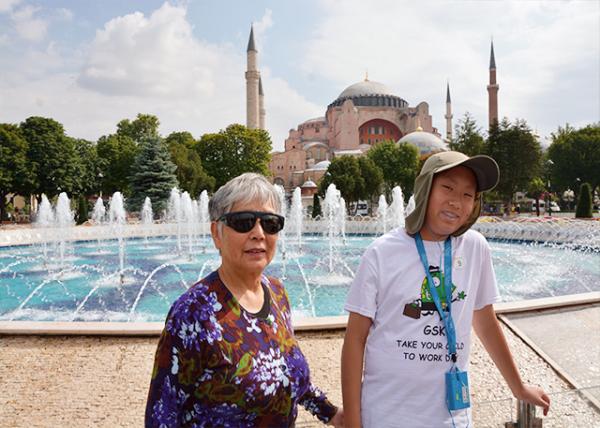 Panorama of Hagia Sophia Grand Mosque Panorama of Hagia Sophia Grand Mosque
(圣索非亚大教堂清真寺·全景 06-26-2015)  Minarets (宣礼塔) Minarets (宣礼塔)
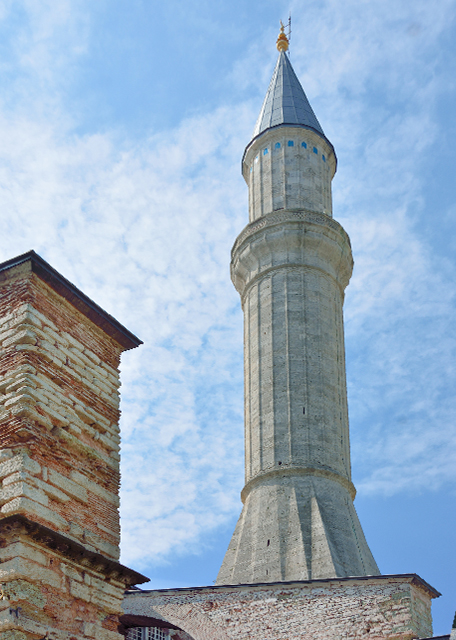
One of the 2 Biggest Minarets Added Later by Selim II (塞利姆二世后来增建的两座最大尖塔之一)
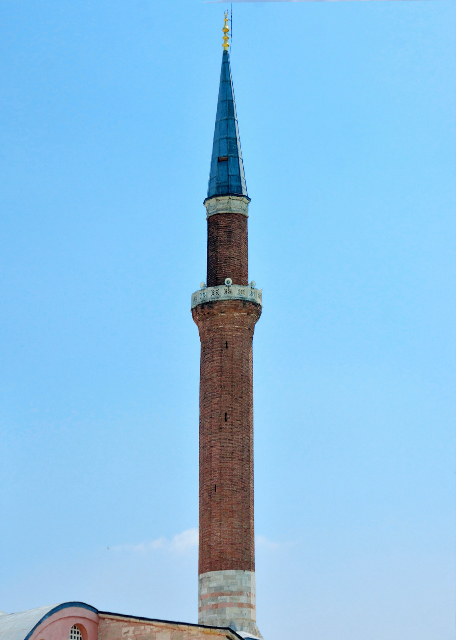
Old Minaret (老宣礼塔)
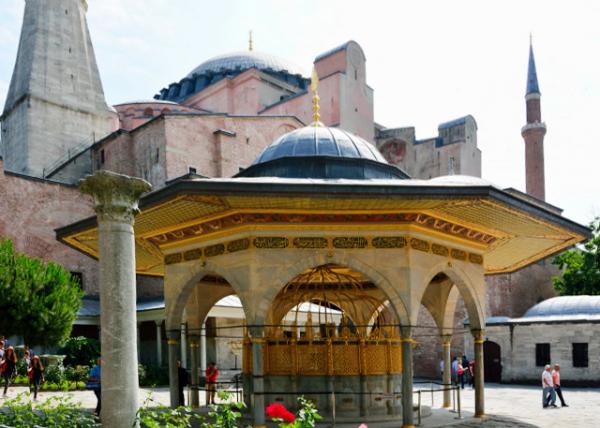 Sadırvan for Ritual Ablutions (供受洗仪式使用的水池) Sadırvan for Ritual Ablutions (供受洗仪式使用的水池)
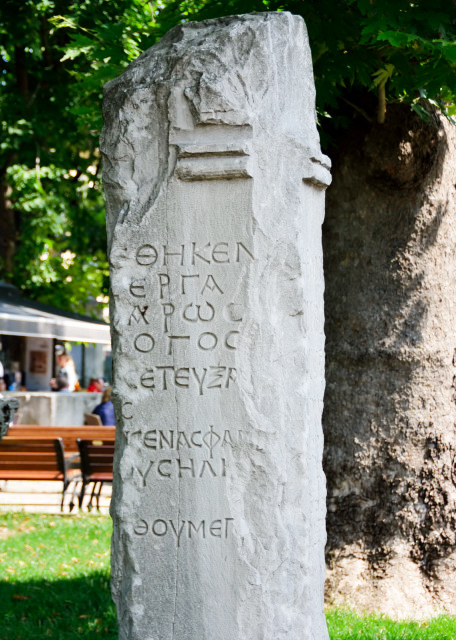
Remains of the Older Church (老教堂遗物)
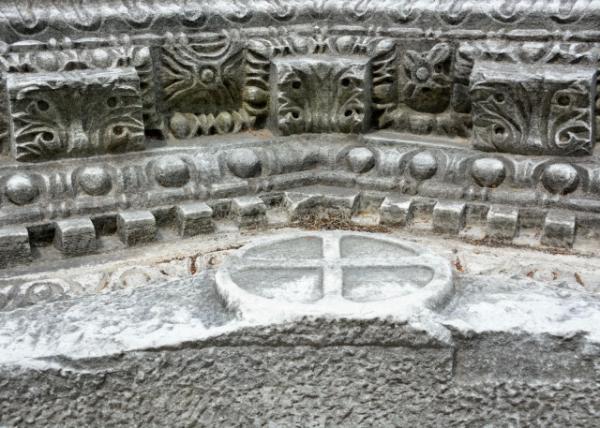
The 5th-Century Remnants of Theodosian (五世纪天赐大教堂遗物) 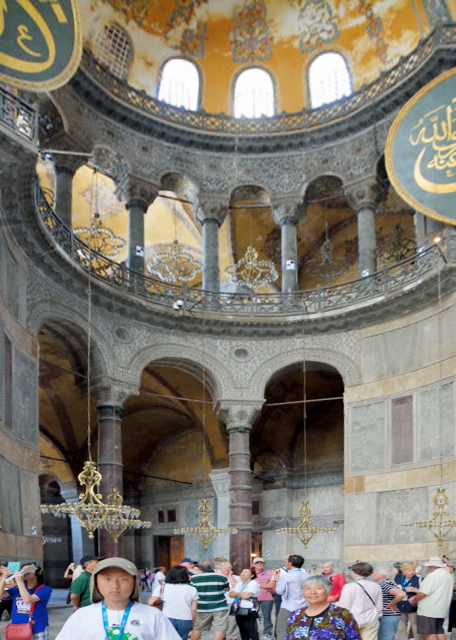
Church of Saint Sava (启蒙者教堂 06-26-2015)
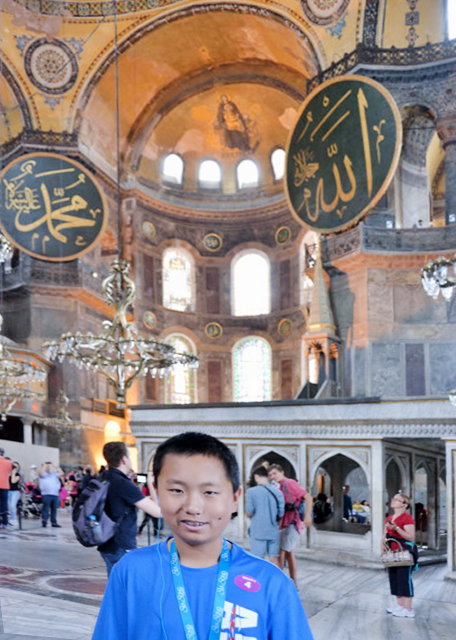
Apse of the Virgin and Child (后殿《圣母子》 06-27-2015)
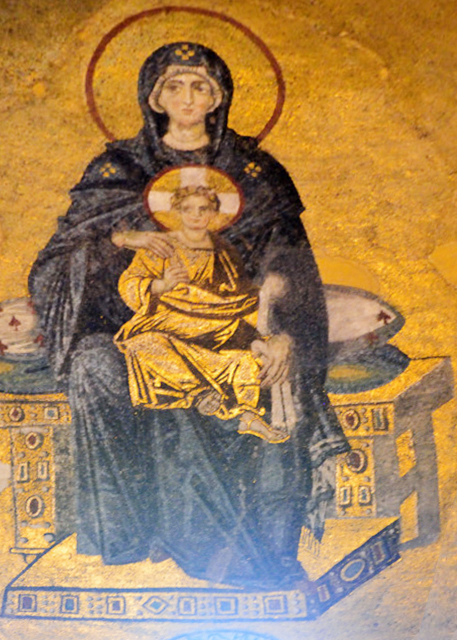
Apse of the Virgin and Child (后殿《圣母子》马赛克) 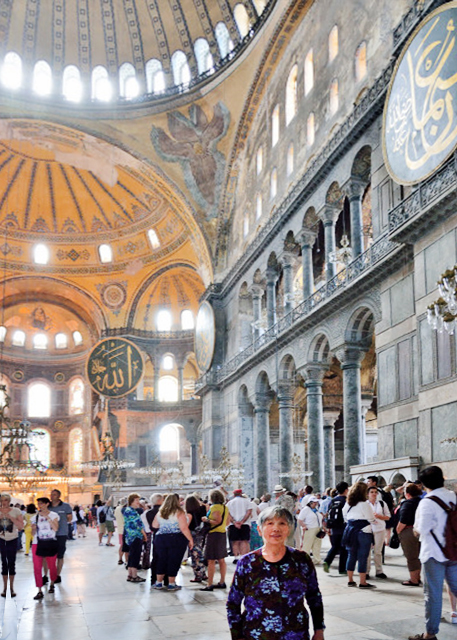
Loge of the Empress (皇后包厢 06-26-2015)
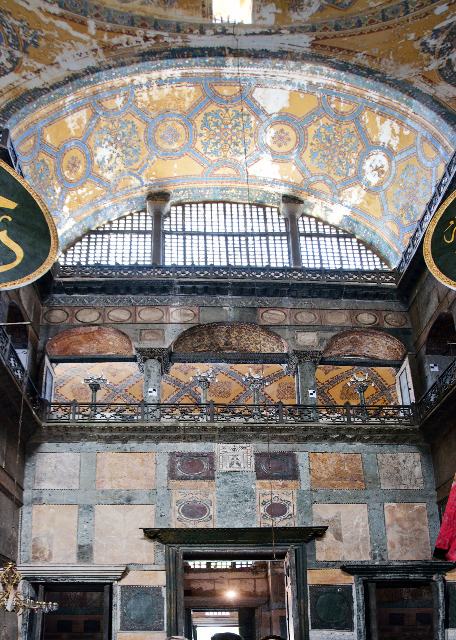
Empress Loge God's Wonder Marble as Medium and the Natural Image in Mosques & Modernism (堪称上帝奇迹的皇后包厢·以大理石作为媒介,展示清真寺与现代主义中的自然图像)
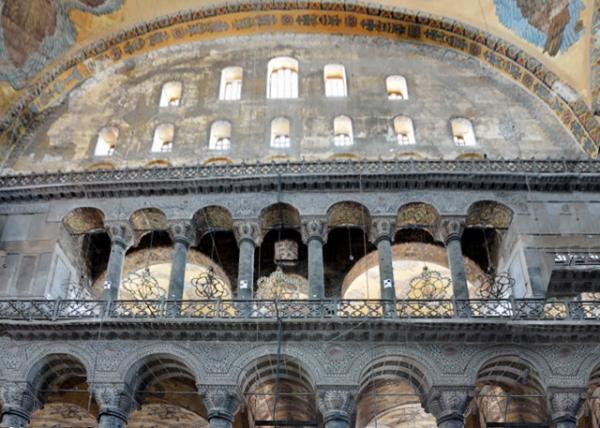 Empress Loge (皇后包厢) Empress Loge (皇后包厢)
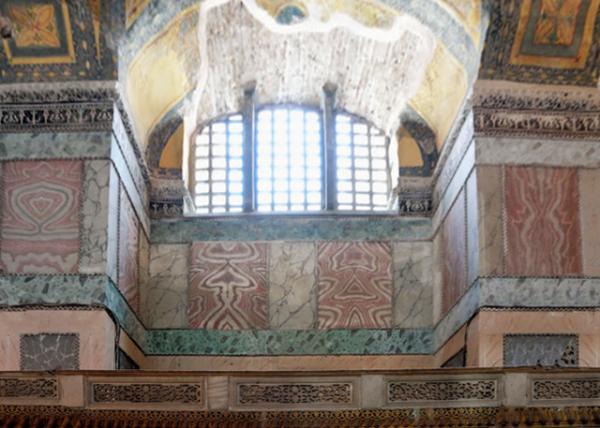 Polychrome Marble Revetment (彩色大理石护墙) Polychrome Marble Revetment (彩色大理石护墙)
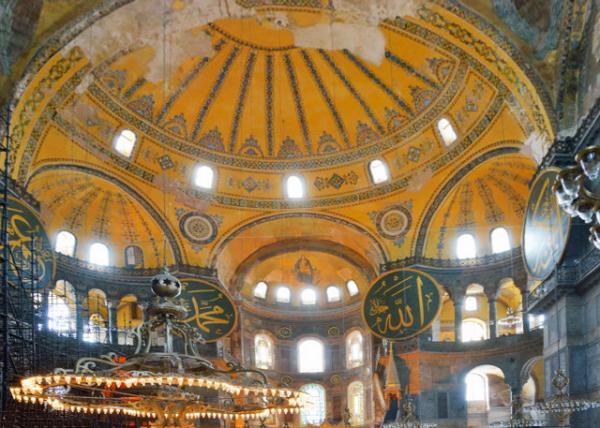 Medallions and Chandeliers (项链垂饰与枝形吊灯) Medallions and Chandeliers (项链垂饰与枝形吊灯)
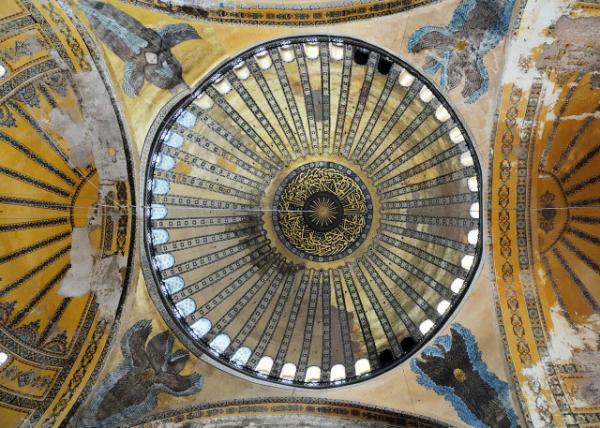 The Face of the Hexapterygon (六翼天使脸) The Face of the Hexapterygon (六翼天使脸)
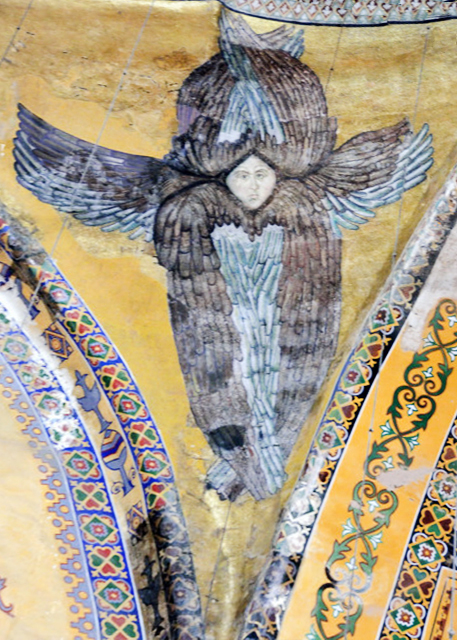
6-Winged Angel (六翼天使)
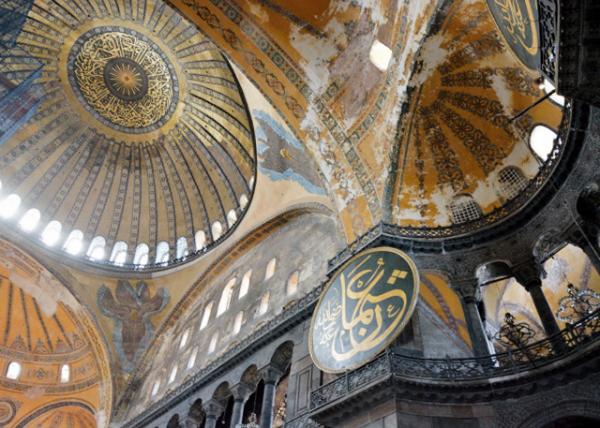 Christian & Islamic Elements (基督教和伊斯兰元素) Christian & Islamic Elements (基督教和伊斯兰元素)
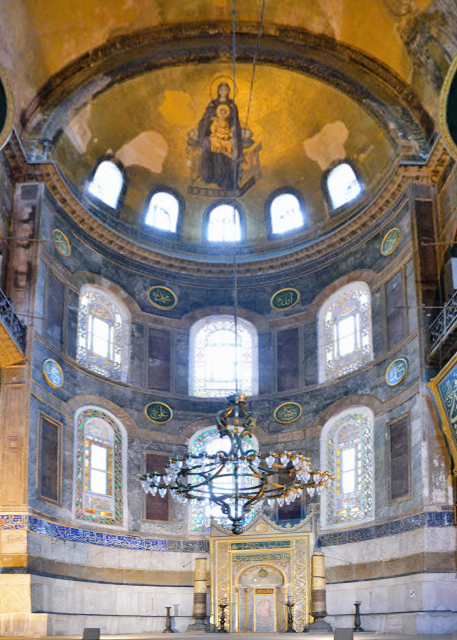
Mihrab, Located in the Apse, Pointing toward Mecca (位于后殿面朝麦加的壁龛) 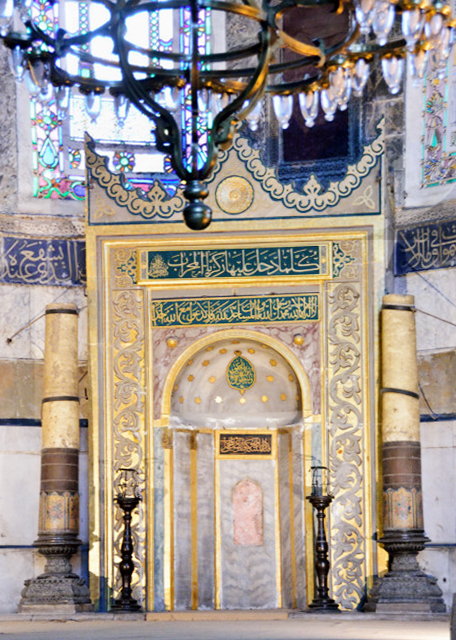
Mihrab in the Apse w/ the Altar, Pointing towards Mecca (位于后殿的壁龛·矗立着指向麦加的祭坛)
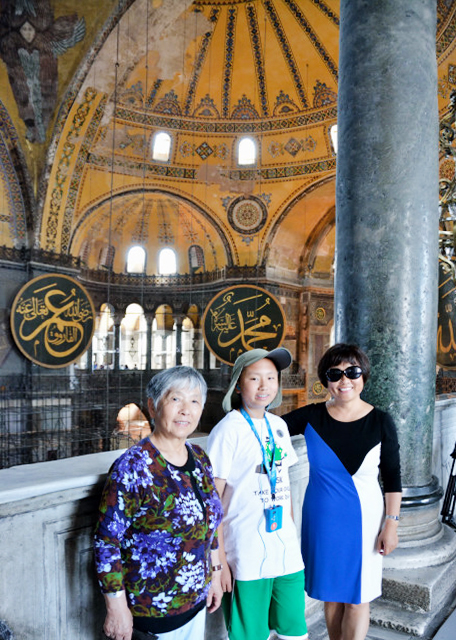
Vaulting Nave (拱形中殿 06-26-2015)
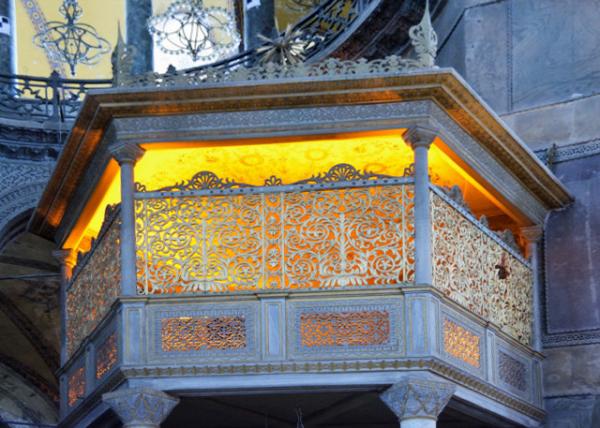 Pulpit (讲坛) Pulpit (讲坛)
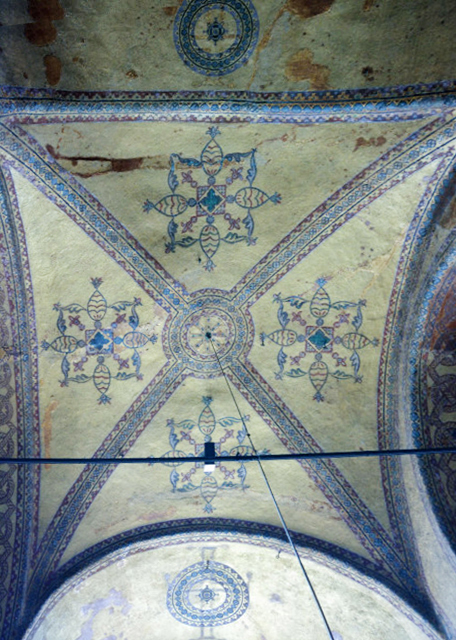
Ceiling Decoration Showing Original Christian Cross Still Visible through the Later Aniconic Decoration (天花板装饰显示出原始的基督教十字架,在后来非标志性装饰中依然可见) 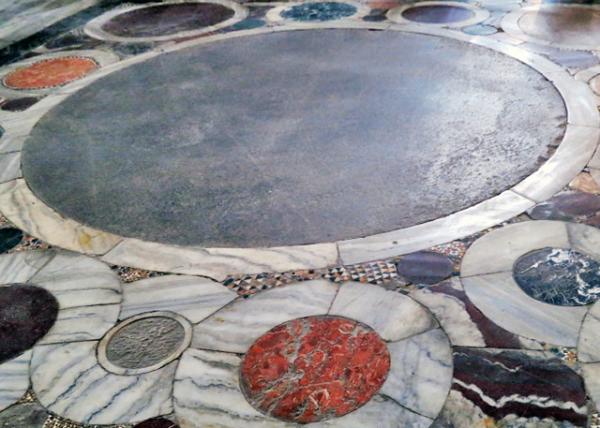 Marble Floor of the Omphalion (脐点大理石地面) Marble Floor of the Omphalion (脐点大理石地面)
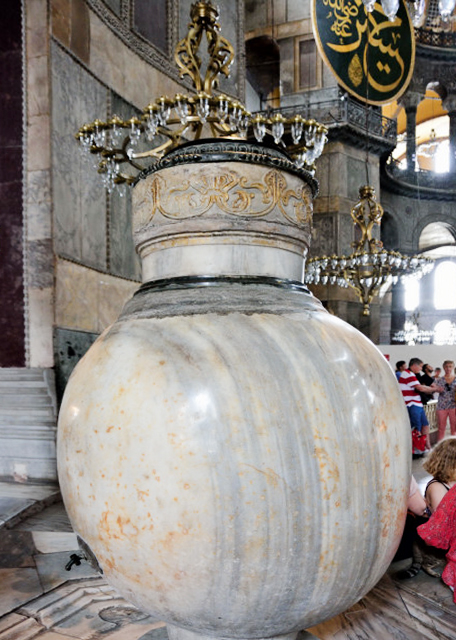
Lustration Urn Brought from Pergamon by Murad III & Carved from A Single Block of Marble in the 2nd Century BC (由穆拉德三世从帕加马古城带来的由一块公元前二世纪完整大理石做成的洁净骨灰缸) 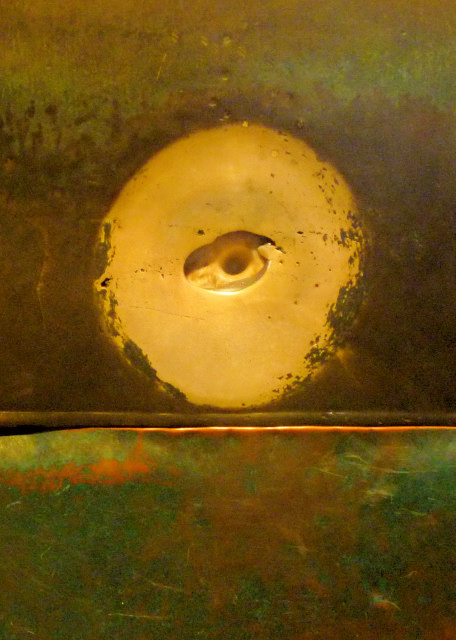
Wishing Column (许愿柱) 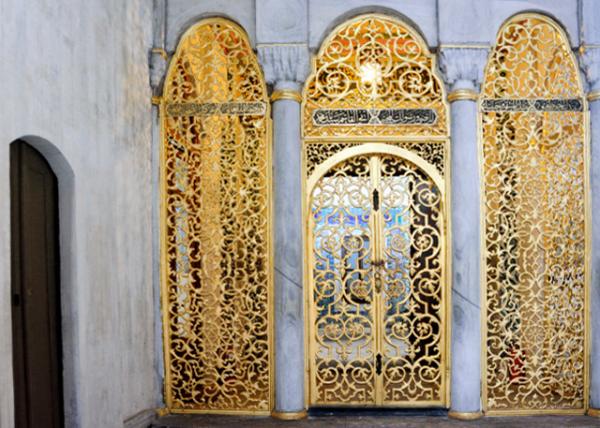 Sultan Mahmud I's Library in 1739 & Decorated w/ the 16th-18th Century Iznik, Kutahya, & Tekfur Palace Tiles Sultan Mahmud I's Library in 1739 & Decorated w/ the 16th-18th Century Iznik, Kutahya, & Tekfur Palace Tiles
(1739年用16—18世纪伊兹尼克、屈塔希和泰富尔瓷砖建成的苏丹·马哈茂德一世图书馆) 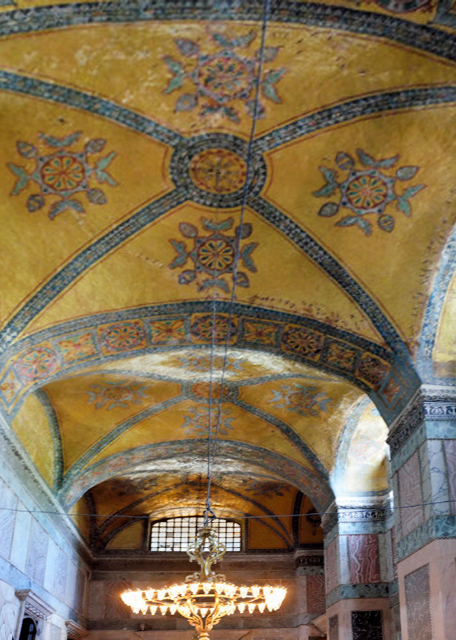
The Loggia of the Empress with/ the Columns Made of Green Thessalian Stone (柱子由绿色塞萨尔石制成的女皇凉廊) 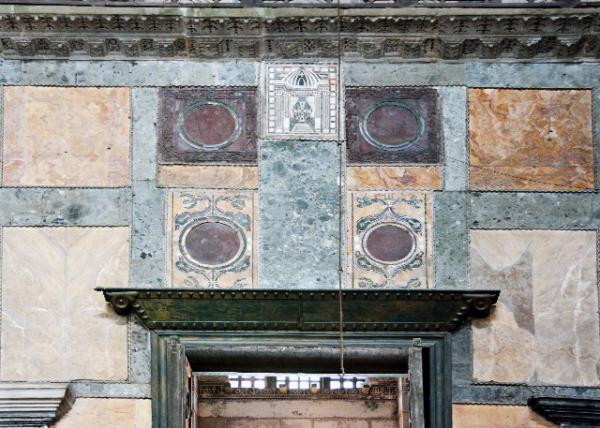 Revetment over Imperial Gate (皇门护岸) Revetment over Imperial Gate (皇门护岸)
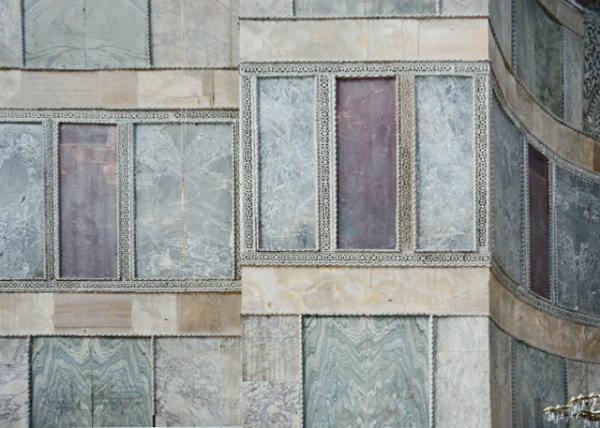 Polychrome Marble Revetment on the Wall of the Gallery Polychrome Marble Revetment on the Wall of the Gallery
(画廊墙壁上的彩色大理石护墙)
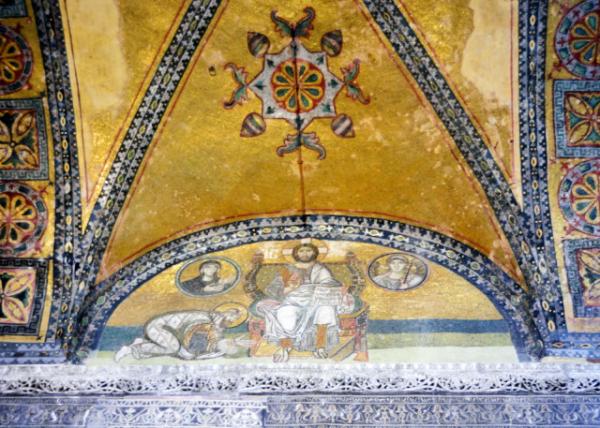 Imperial Gate Mosaic (帝王门马赛克) Imperial Gate Mosaic (帝王门马赛克)
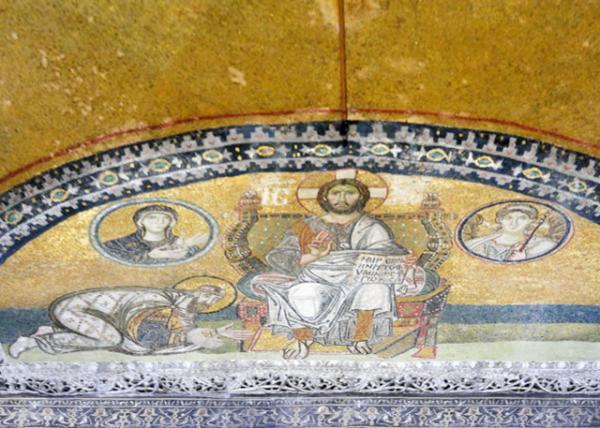 Details of Imperial Gate Mosaic (帝王门马赛克细节) Details of Imperial Gate Mosaic (帝王门马赛克细节)
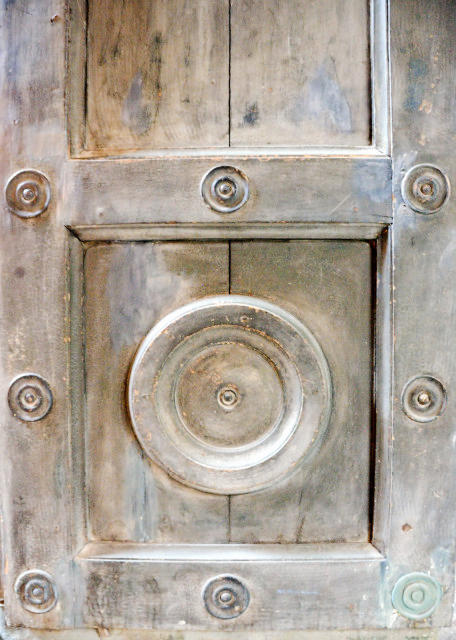
Imperial Gate Relief (帝王门浮雕) 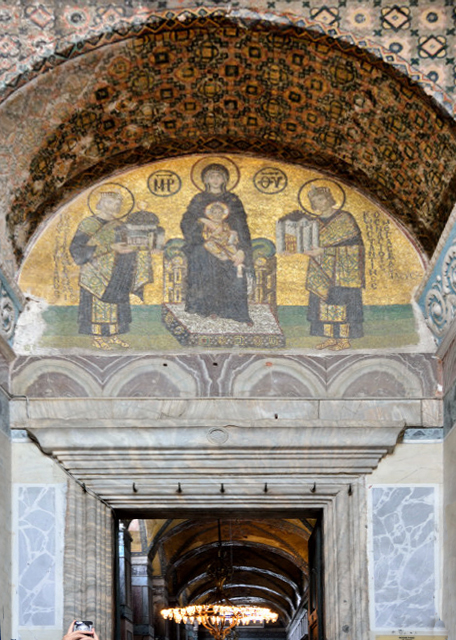
10th-Century Southwestern Entrance Mosaic Panel (西南门·10世纪西南门马赛克板) 
Southwestern Entrance (西南门)  The Deësis Mosaic (迪西斯 "代祷" 马赛克《三圣像》) The Deësis Mosaic (迪西斯 "代祷" 马赛克《三圣像》)
 Detail from the Deësis Byzantine Mosaic of Jesus Christ Pantocrator Detail from the Deësis Byzantine Mosaic of Jesus Christ Pantocrator
(迪西斯拜占庭马赛克的细节·耶稣基督万能)  Byzantine Mosaic of Jesus Christ Sitting on Throne w/ Empress Zoe & Emperor Constantine IX Monomachus Byzantine Mosaic of Jesus Christ Sitting on Throne w/ Empress Zoe & Emperor Constantine IX Monomachus
(圣母子坐在艾琳·杜卡斯女皇和约翰二世科穆宁皇帝之间)  Byzantine mosaic of Jesus Christ Sitting on Throne w/ Empress Zoe & Emperor Constantine IX Monomachus Byzantine mosaic of Jesus Christ Sitting on Throne w/ Empress Zoe & Emperor Constantine IX Monomachus
(拜占庭马赛克·耶稣基督与皇后佐伊“生命”和皇帝君士坦丁九世莫诺马库斯一起坐在宝座上) Crosslinks(相关博文): Turkey(出游土耳其)
Europe(欧洲掠影) 6th Grade(初中一年级)
|
